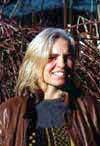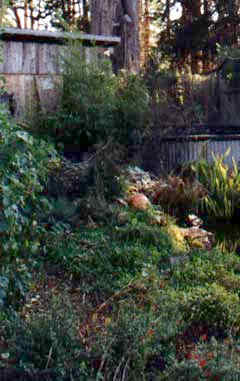PERMACULTURE: California Style
An Interview with Penny Livingston
Part One of a three-part series
PART TWO
There is a myth that as the human population increases, food, and
arable land to grow it on, will necessarily be in short supply.
Competition for land and other dwindling resources will, in turn,
destroy the world's remaining forests and ecological preserves.
But there could be another outcome, another approach to life, an
new beginning. In her three-part, exclusive interview with Ecotecture,
Permaculturalist Penny Livingston tells us how.
Learn more about Penny and her Permaculture Institute of Northern California (PINC).
Ecotecture: How did you first get interested in Permaculture, first discover it?
Penny Livingston: I have a background in landscape design, and I was getting to a place where I wanted to work with people connecting them back to the natural world. As a landscape designer, you get a lot of people saying, "I want a no-maintenance garden." There are people who want to sit out on their porch or their deck and look at a beautiful garden and not have any interaction with it. So I did a lot of natives, and habitat, and getting birds in there. I've always thought that there is more than just covering the ground with plants. It is really about, "what are the functions of the plants, and what else can they be doing besides just looking beautiful? Can they be make oxygen, process water, provide habitat, heal people?" When I found out about Permaculture, that pretty much fit the bill.
Ecotecture: How did you find out about Permaculture?
PL: Well, (laughs) I went through a crisis where I fired a client. It didn't feel very good, but it was just one of those things where I was working for very wealthy people and constantly getting my money talked down, talked down, when I charged so little, at the time anyway. It was just so offensive to me, the I said, "I think you should find somebody else." I had a big hole in my schedule after firing this guy. A friend of ours from Lost Valley Education Center in Oregon was staying with us. I was really upset. I didn't even want to come to dinner. I was in my office, and stewing, wondering, "What am I doing with my life, comforting the rich, building these things . . . what's it all for, anyway? It is a luxury."
Ecotecture: When was that?
PL: This was around 1990. To have somebody come in and design and put in your landscape for you is not a necessity, it is a luxury. It was getting to the place where what I was doing seemed so meaningless.
So, my friend talked about a Permaculture course starting three days hence. I didn't have a clue as to what Permaculture was. She talked about a blending of ecology and community economics. That was a hook for me, the community economics part. So, I went, and took a two-week (Permaculture) intensive design course. It turned my world upside down, or, right side up, let me put it that way (laughs).
Ecotecture: Where was the course taught?
PL: It was at the Lost Valley Education Center. It was in December. It was taught by Tom Ward, June DeHobbs, and Rick Valley, who were three students of (Permaculture Founder) Bill Mollison's.
Ecotecture: And it turned your world right side up?
PL: Yeah. Yeah, because everything made so much sense. But I wasn't real clear on what Permaculture was and how much of what they were teaching was their opinions and how much was the curriculum. So, I ended up taking a couple more courses. One of them was with Bill Mollison. Since then I have become good friends with him. He stayed here and I've hosted him and I've gotten a real in-depth look from the horse's mouth, so to speak, because he was one of the co-founders, with David Holmgren, of the concept of Permaculture. David Holmgren was a student of environmental design and Bill was a professor of forest ecology at the University of Australia, or perhaps Tasmania. They put the whole concept together.
Ecotecture: I've heard Bill Mollison referred to as the "Tasmanian Devil."
PL: Oh yes.
Ecotecture: What's he like?
PL: He's a delightful human being. He has a persona of being a rather irascible curmudgeon when he gets on stage. He'll rant, he is an iconoclast, he likes to poke at everyone's sacred cows, and he does it well-pisses people off. He also angers people into action. He is very effective at doing that. He really gets people to start looking at themselves in a more critical way.
But in private, at home, he's like a big bear. He is so interested in everything. His idea of a good time is to go to used bookstores and buy books, which is so fun to do with him. He also cooks really good food, particularly sea food. Fresh, hot, sea food. That is what we do a lot when he is here. He's not particularly interested in looking at everyone's garden, and giving everyone advice. In fact, he shuns that. He really likes to just kick back, tell stories, talk about new ideas, the old days, and he is a delight to be around. He spent quite a bit of time here, and, when he leaves, I feel very sad because I never know if it is the last time I will see him.
Ecotecture: How old is he now?
PL: I'm not exactly sure. I think in his early 70's. He quit smoking, the first of this year. It was pretty funny, you know, this "sustainability" guy smoked like a fiend. So he is also sort of a walking contradiction himself, like so many of us are. He's very accessible and down to earth and a regular person.
I think when I first met him, before I met him, I expected to see a grouchy, aloof, disconnected, burnt-out, irascible, egotistical guy.
Ecotecture: Sounds like he has a good reputation, at least.
PL: (Laughs) That is what I expected. I didn't know. You just think, here is somebody who is a global figure . . . But he is not at all any of that. He is really fun.
I feel very grateful not only that I have gotten to be friends with him and to get to know him the way I have, but also that he decided to not go out in the bush and isolate himself, that he did come back (from his trek in the wilderness) and bring this design system with him and walked the globe and shared it with community after community for two or three decades now. I feel indebted to him, in a way, and extremely grateful that he did that. It certainly changed my life.
I don't know of any other single human being that has done more to empower communities to start taking responsibility. There are more Permaculture people doing silent, quiet — just doing the work — then there are in any of those big USAID, World Bank, or Peace Corp projects combined. There are literally tens of thousands of people doing this all over the world involved in on-the-ground Permaculture projects.
But they are not announcing it. There are journals where people write about what they are doing, but, often, it is very difficult to find the people because they are just doing it. The Permaculture community is very anarchistic.
Ecotecture: What happened after you took that first Permaculture course?
PL: I came home and basically did business as usual, still. People would talk to me and say how was it, what happened, and I would say, "I can't even talk about it. I'll get back to you (laughs)." My brain was so full. I went through all my notes, put 'em on a computer, rearranged them. That really helped me to remember everything. Because after about a week and a half I went brain dead. You get so much information, especially in the old way of teaching — and it is still being taught this way — lecture, lecture, lecture. Whereas in our (PINC) courses, as much as possible, we get out there and do hands-on every afternoon. We break up the input of information so people can process it.
So, it wasn't until I went to the Green Gulch Zen Center near Bolinas, California, where they were doing a workshop on sustainability . . . I just happened to read about it that morning, when it was happening, when I opened up the Green Gulch newsletter. I dropped everything, jumped in the car, went down there, and said, "I want to hear what you have to say."
As we were walking along, and looking at the landscape and what was happening there . . . you can see that it used to be a ranch, they pulled the cows off, it's has been probably three years or more with no cattle there, so you can see the land re successioning itself and coming back. So it is a good example, the hills there, and, all of the sudden, things just started trickling out of me. An understanding happened.
I don't take ecology classes — scientific biology. I do have a lot of friends who are naturalists that have really given me great information, but there was a pattern, something clicked where I could see the pattern and see flow patterns. That is a big part of Permaculture. That is the tool you use, along with observation. Those are the two things, observing and pattern understanding and recognition — mostly you are observing and looking for patterns.
Ecotecture: What kind of patterns?
PL: Oh, any kind of patterns. That's the beauty. It could be flow patterns, patterns of succession, air flow, water flow, pathway flow, human dynamic patterns. Just looking for patterns and identifying them has helped my whole understanding of complex systems.
Once you identify a pattern, you work within that pattern, work within that flow. It is an understanding that just comes. It is a non-intellectual understanding. In fact, I have been musing about how much of what we attribute to intuition is really pattern recognition, and maybe vice versa (laughs). Because it comes in very much the same way. You see, when you are looking at a tree, for example, or you are watching a river or creek flow, you are getting so much information that you don't even know that you are getting it, consciously.
So as a designer I make decisions that just feel right. What Permaculture brought to me was learning how to trust my intuition. I really think a lot of what I was calling intuition was simply complex pattern recognition. As a designer, I could tap into that, and I ended up with successful designs. Especially if one is working with living things, landscape, for example, you are working with plants, soil, critters, water, wind, and weather (dynamic patterns.) It's not like building cabinets and putting them in someone's house or getting a piece of furniture. It is a living system that you are designing with it.
So, a successful design requires very little maintenance, and creates a healthy environment and high production. That production can be interpreted as habitat, clean water, a comfortable place to be, definitely food production and raw materials of all sorts for human use. When you start looking at the pattern you realize that even the migrating Warblers that are coming in and eating the little caterpillar that would normally be eating your plants — that is human use too. So habitat, if you want to look at it that way, has a human function to it as well, that of maintaining a balance so we don't have to do it.

